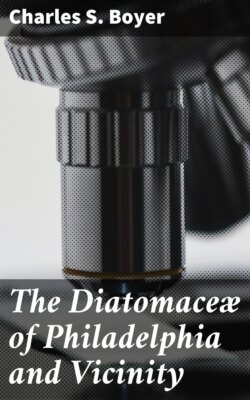Читать книгу The Diatomaceæ of Philadelphia and Vicinity - Charles S. Boyer - Страница 31
На сайте Литреса книга снята с продажи.
Actinocyclus Ehr. (1837)
Оглавление(actis, a ray, and cyclos)
Valve circular or elliptical; surface flat at the centre, sloping toward the border. Central space usually evident, rounded or irregular. Markings rounded, granular, punctiform, in radial, or nearly radial, rows, sometimes fasciculate. A nodule, more or less evident, is found near the border which is usually striate.
Chromatophores round discs or granules.
ANALYSIS OF SPECIES
| Valve circular, rows radial, hyaline lines at the border | barkleyi |
| Valve circular, rows fasciculate | moniliformis |
| Valve elliptical | ellipticus |
The nodule is generally supposed to be a thickening of the cell-wall, and, in the opinion of Rattray, a projection outward, but "whether there may not be at the same time a slight inward protuberance is difficult to determine," though, as a rule, he seems to "think there is not."
ACTINOCYCLUS BARKLEYI VAR. AGGREGATA RATTR.
Surface flat from centre to semi-radius. Central space irregular, sometimes with a few scattered granules. Markings round with central dots distinct, about 7 at the centre, decreasing in straight radial rows to 12 in 10 µ at the border, where they form moniliform striæ. Border narrow with striæ about 16 in 10 µ. Hyaline interspaces at the origin of the shorter rows, but not at equal intervals. At the border, linear hyaline spaces occur at somewhat irregular intervals between the moniliform striæ owing to the termination of certain radial rows before they reach the circumference. Nodule small, from one-seventh to one-fourth the radius from the border.
According to Rattray the distinction between A. ralfsii and A. barkleyi is partly in the absence of the zone arrangement of the hyaline spaces in the latter, and to the slight differences in the number of granules. The variety aggregata differs from the type form of barkleyi mainly in the distance of the nodule from the border. I have specimens from the blue clay material at Walnut St. Bridge, and from Smith's Island, in which the distance from the border in one case is, as stated above, quite different from that in the other. In specimens from Morris Cove, Conn., the locality referred to by Rattray, variations occur.
Blue clay.
Pl. 6, Fig. 1.
In the figure the subulate hyaline spaces at the border are, in some instances, wider than usual.
ACTINOCYCLUS MONILIFORMIS RALFS
Surface flat, from centre to about five-sixths of the radius. Central space rounded, with one or more granules. Markings, 8 in 10 µ, round, in radial rows, fasciculate, the oblique transverse rows irregular, very slightly decreasing until near the edge of the flattened zone, and then suddenly decreasing and appearing as decussating lines oblique to the border. Apiculi distinct, interfasciculate within the border. Nodule quite evident, surrounded by a rather wide irregular hyaline space on the margin of the flattened zone in the middle of the fasciculus. Border wide, with striæ about 20 in 10 µ.
Blue clay. Port Penn. Not common.
Pl. 6, Fig. 2.
Equivalent to Actinocyclus ehrenbergii, H. L. S. Type Slide 10.
In a valve from Port Penn, Delaware Bay, two nodules occur nearly opposite each other.
ACTINOCYCLUS ELLIPTICUS VAR. DELAWARENSIS N. VAR.
Valve rhombic-elliptical. Markings somewhat angular, 6 in 10 µ at the centre where they are sub-concentric, thence decreasing in lines radiating more or less toward the border, where they suddenly become punctiform, striæ about 20 in 10 µ. Border equal to one-fifth the radius. A nodule is found on the inner side of the border. Apiculi apparently absent.
The markings are larger than in the Richmond forms which are associated by Rattray with Actinocyclus ellipticus Grun. The form corresponds closely to Witt's Cestodiscus ovalis var.? (Witt, Polierschief. von Archangelsk-Kurojedowo, Pl. 8, Fig. 2), except as to the border. It does not answer to Van Heurck's figure or any other.
Blue clay. Very rare.
Pl. 3, Fig. 6.
